The last post I wrote about the garden was back in late June, and a lot of stuff has changed since that point. I thought I'd show my readers what has happened in the time between then and now.
Although I am attempting to convert a large portion of my garden to a system of edible perennial plants, there will always be a spot for in the yard for growing classic annual favorites, like tomatoes. Today, I'd like to offer a glimpse at what both annual and perennial plants produced for my family to eat over the summer season.
Annuals
Tomatoes - My tomatoes were glorious this year! So many delicious tomatoes were eaten by the entire Dow family this summer. The "Brandy Boy" variety started to ripen in early July, with the rest of the varieties blushing shortly thereafter. With the exception of "Rio Grande," they have been putting out delicious tomatoes for us to eat ever since. Production has slowed to a crawl, however, over the past month, as early blight, cooler temperatures and shorter days all have played a part in limiting each plant's growth. Still, we were able to eat fresh, delicious tomatoes all summer long and have plenty to share with relatives, friends and neighbors.
Beans - Oddly enough, the bush beans did outstanding this year, but my pole beans just suffered in the hot, dry summer conditions. I harvested a pretty good amount of "Royal Burgandy" purple beans, as well as a few classic "Cherokee Wax" yellow beans. Enough for a few side dishes with dinner here and there. Unfortunately, I probably only picked two or three "Kentucky Wonder" green beans before the plants' leaves turned yellow and wilted, eventually killing the entire plant. I really don't know what happened, but I'm guessing the stress from moles digging under their roots and lack of consistent rainfall helped contribute to their demise. I've had such good luck in the past with "Kentucky Wonder," though, so I will try to grow them again next year.
Okra - My little okra seedlings that were shown in my last post grew into 4 foot (about 120 cm) "shrubs" with huge, interesting leaves and lots of flowers and pods. It's just too bad that after cooking okra several different ways, I can't get past the taste. It's just terrible to me. It's really a shame I can't figure out a way to prepare it to my liking, because this plant produces pods like crazy and it takes no effort at all to grow. I hardly ever watered it, and besides a few tiny leaf miners, no pest or disease issues to speak of. I probably won't grow it again, though... it takes up a lot of valuable gardening real estate that could have gone to more palatable veggies.
Molokhia - I was pleasantly surprised at how good this super nutritious leafy green tasted. It has a texture more akin to a kale leaf, but with a very mild greens taste... sort of a mild spinach. True to its reputation, this plant required very little care from me during the entire time it's been growing. It was never really attacked by bugs, and although it developed a few yellowish-black rings on some of the leaves, it keeps chugging along just fine. The leaves are great to use in salads and soups, but I prefer to just collect a bunch of them to add to fruit & oatmeal smoothies, as they add a lot of extra nutrition, without changing the flavor very much, if at all.
The plants are now developing a long, tubular seed pod, which I understand is also edible and supposedly quite tasty, but I have plans to save those seeds to grow more molokhia next year. This year's experience has taught me that with molokhia, the more plants, the better. Because the leaves are so small and the growth rate is not as fast as I'd hoped, next year I will be planting many more square feet of this plant, similar to how I would grow spinach or lettuce, to ensure I have an adequate supply of leaves to harvest.
Perennials
I just barely scratched the surface of my journey into perennial agriculture this year, as I have many more perennial crops I intend to grow next season. Nevertheless, some of the initial perennial plants I grew started producing this year for the first time.
Grapes - After three years in the ground, my grape vine produced at least a dozen bunches of delicious grapes that ripened just at the end of July and beginning of August. Although keeping the vines growing in the direction that I wanted them to grow was a small bit of labor, this plant produced lots of fruit that was virtually trouble-free. I'm excited to see how much larger next year's crop will be, considering how large the vine is now. Grapes truly belong in a permaculture system, simply due to their ease of growing and the abundance of food they produce.
I did also attempt to propagate my grape vine via cuttings of both soft and woody growth, but none of them formed root systems before the cuttings shriveled up and died. Perhaps next year I will try again, but using root hormone on the tip of the cutting to stimulate root growth a bit faster.
Thyme - This herbaceous plant needed a lot of water at first, but it seems to be established well enough now that I can leave it be. I've never used thyme much in cooking until this year, but it does have a very good flavor for seasoning other foods. I made pan-seared potato wedges seasoned with fresh thyme in olive oil and it was delicious.
In addition to the standard culinary thyme I grew from seed, I was able to obtain a lemon-scented variety that was being thrown out by a local restaurant. Both varieties are still growing happily in different areas of my garden.
Sage - I will admit that I did not use this herb in any food that I made this year, but I was happy to grow it none-the-less. It has a strong, distinct scent that I would liken to an earthy cologne of sorts that wafts around the garden when it is brushed against, or when the wind blows. It has beautiful leaves that don't take up much space and is trouble-free to grow, provided it is given ample water and a thick layer of mulch around it when first getting established. I believe that it will be more useful to me as a medicinal plant than an edible plant in the future, based on some promising studies on its use to treat migraine headaches.
Sorrel - I thought I had done something wrong when growing sorrel this year. The little sprouts looked so healthy, and they stayed that way for a little while until the heat of summer kicked in. I kept the seedlings watered and weeded around them constantly, but they just seemed to disappear a little bit more each day. After a while I stopped caring, thinking they were goners, but a second flush of leaves started to appear shortly after mid July. The plants have already started spreading from runners as well. Sorrel's use in my garden has been mostly for salads, and occasionally I mixed them into smoothies. I can't wait to see what how it looks next spring.
Asparagus - The name of the game with this edible perennial plant is patience. If you recall from my last post on the garden, I got very impatient and just assumed the asparagus had died, but a few weeks later a bunch of "leaves" popped right out of the ground. Well, since that time, the three crowns that did grow have been slowly (and I mean slooooowly) adding a spear or two every couple of weeks. I now understand why the plant can't be harvested any time in the first few years. There's really not even much to harvest.
Still, I am thankful that the crowns did eventually grow. The plants seem healthy as far as I can tell, although my son managed to mangle the one purple variety pretty badly. I'm planning on buying more crowns next year for sure.
Other perennials - My wife managed to find some "wild" raspberries in the woods behind our house, so we transplanted one of the canes into our garden. The other two varieties we already had produced lots of delicious berries for us.
The only other edible perennial plants that I have are four blueberry bushes, and two pear trees. The blueberries did produce a lot more berries than in previous years, but they unfortunately got snacked on by the birds before we could get to it. As for the pears, well, the trees developed fire blight last year and had to be severely pruned, which hurt its spring growth earlier this year. Between both trees there was only one flower blooming when they budded out. And as I've mentioned before, we need another variety of pear tree to provide pollination for the blooms, since apparently same varieties won't pollinate each other. We didn't research this beforehand and bought two "Barlett" pear trees.
The new pear tree will planted later this winter, and we plan to use netting on the blueberries to keep the birds from eating them. Hopefully, that will solve each problem next year.
Final Thoughts
I'm convinced that 2015 was the most productive gardening season for the Dow Dominion yet. We enjoyed a long harvest of spring veggies like lettuce, kale and spinach. Then, right as those tender greens were bolting, we started harvesting lots of delectable tomatoes, several types of beans, berries of all sorts, and various herbs like oregano, basil and thyme. We did have a few failures, but less than any year prior. The Dow household is still far from having a self-sufficient food supply, but this year we made great progress towards that lofty goal... more so than ever before.
I think the most valuable lesson I learned from this season is just to try! In the past, I've been reluctant to test different things that I thought would be a good idea, maybe because it seems like too much work, or that it wouldn't work at all. I let go of some of those fears this year, as I really don't have much to lose from just trying out different plants, different spots to grow, different ways to improve the soil, and different ways to utilize water. Just try it, keep doing the things that work, and drop the things that don't!
Now that fall is here, the production of my garden is pretty much done, so I'm using the time to clean up dead plant material, spread leaf mulch over my garden beds, and plan for an even more productive year in 2016. I hope you enjoyed taking a look at the photos of my garden this year, and perhaps inspired you to try some of the various plant varieties I grew this year.
I have several new articles in the works, some of which deal with the apple tree nursery I'm going to be starting, some covering various topics of backyard permaculture, and others completely unrelated to agriculture. If you enjoyed this post (or any of my articles), please consider subscribing and sharing with your friends! Thanks for reading, and come back soon for more content.
Although I am attempting to convert a large portion of my garden to a system of edible perennial plants, there will always be a spot for in the yard for growing classic annual favorites, like tomatoes. Today, I'd like to offer a glimpse at what both annual and perennial plants produced for my family to eat over the summer season.
Annuals
Tomatoes - My tomatoes were glorious this year! So many delicious tomatoes were eaten by the entire Dow family this summer. The "Brandy Boy" variety started to ripen in early July, with the rest of the varieties blushing shortly thereafter. With the exception of "Rio Grande," they have been putting out delicious tomatoes for us to eat ever since. Production has slowed to a crawl, however, over the past month, as early blight, cooler temperatures and shorter days all have played a part in limiting each plant's growth. Still, we were able to eat fresh, delicious tomatoes all summer long and have plenty to share with relatives, friends and neighbors.
 |
| July 11th, when the tomatoes first started turning colors |
 |
| Brandy Boys almost completely ripe |
 |
| This variety, "Beefsteak," rivaled the production of Brandy Boy |
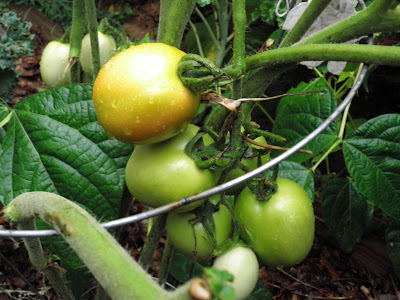 |
| Rio Grande did put out a few clusters, but quickly succumbed to Early Blight |
 |
| Only took one picture of "KBX," simply because they got eaten too quickly! Yum! |
 |
| One of several large hauls of tomatoes we had this year |
Beans - Oddly enough, the bush beans did outstanding this year, but my pole beans just suffered in the hot, dry summer conditions. I harvested a pretty good amount of "Royal Burgandy" purple beans, as well as a few classic "Cherokee Wax" yellow beans. Enough for a few side dishes with dinner here and there. Unfortunately, I probably only picked two or three "Kentucky Wonder" green beans before the plants' leaves turned yellow and wilted, eventually killing the entire plant. I really don't know what happened, but I'm guessing the stress from moles digging under their roots and lack of consistent rainfall helped contribute to their demise. I've had such good luck in the past with "Kentucky Wonder," though, so I will try to grow them again next year.
 |
| Some of the Royal Burgandy bush beans forming |
Okra - My little okra seedlings that were shown in my last post grew into 4 foot (about 120 cm) "shrubs" with huge, interesting leaves and lots of flowers and pods. It's just too bad that after cooking okra several different ways, I can't get past the taste. It's just terrible to me. It's really a shame I can't figure out a way to prepare it to my liking, because this plant produces pods like crazy and it takes no effort at all to grow. I hardly ever watered it, and besides a few tiny leaf miners, no pest or disease issues to speak of. I probably won't grow it again, though... it takes up a lot of valuable gardening real estate that could have gone to more palatable veggies.
 |
| Okra has a beautiful flower that attracts many types of insects |
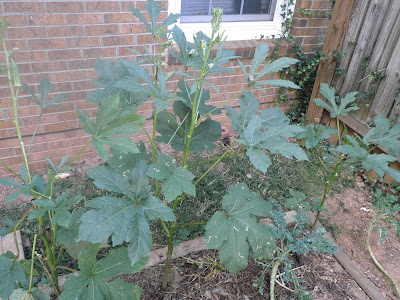 |
| My okra plants have grown quite tall, at least 4 feet (~120 cm) |
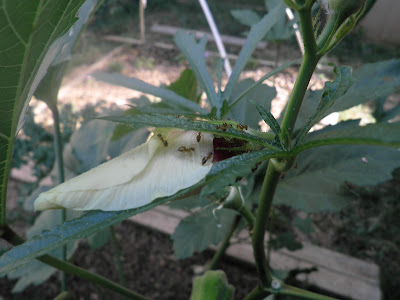 |
| These golden ants love harvesting nectar from an okra flower |
 |
| A fully formed, albeit strangely-shaped, okra pod |
Molokhia - I was pleasantly surprised at how good this super nutritious leafy green tasted. It has a texture more akin to a kale leaf, but with a very mild greens taste... sort of a mild spinach. True to its reputation, this plant required very little care from me during the entire time it's been growing. It was never really attacked by bugs, and although it developed a few yellowish-black rings on some of the leaves, it keeps chugging along just fine. The leaves are great to use in salads and soups, but I prefer to just collect a bunch of them to add to fruit & oatmeal smoothies, as they add a lot of extra nutrition, without changing the flavor very much, if at all.
The plants are now developing a long, tubular seed pod, which I understand is also edible and supposedly quite tasty, but I have plans to save those seeds to grow more molokhia next year. This year's experience has taught me that with molokhia, the more plants, the better. Because the leaves are so small and the growth rate is not as fast as I'd hoped, next year I will be planting many more square feet of this plant, similar to how I would grow spinach or lettuce, to ensure I have an adequate supply of leaves to harvest.
 |
| Molokhia resembles some common weeds at first glance |
 |
| The long seed pods of molokhia remind me of a cucumber |
Perennials
I just barely scratched the surface of my journey into perennial agriculture this year, as I have many more perennial crops I intend to grow next season. Nevertheless, some of the initial perennial plants I grew started producing this year for the first time.
Grapes - After three years in the ground, my grape vine produced at least a dozen bunches of delicious grapes that ripened just at the end of July and beginning of August. Although keeping the vines growing in the direction that I wanted them to grow was a small bit of labor, this plant produced lots of fruit that was virtually trouble-free. I'm excited to see how much larger next year's crop will be, considering how large the vine is now. Grapes truly belong in a permaculture system, simply due to their ease of growing and the abundance of food they produce.
I did also attempt to propagate my grape vine via cuttings of both soft and woody growth, but none of them formed root systems before the cuttings shriveled up and died. Perhaps next year I will try again, but using root hormone on the tip of the cutting to stimulate root growth a bit faster.
 |
| A ripening cluster of grapes, with many already plucked and eaten! |
 |
| Posing with my grape vine earlier in the summer |
Thyme - This herbaceous plant needed a lot of water at first, but it seems to be established well enough now that I can leave it be. I've never used thyme much in cooking until this year, but it does have a very good flavor for seasoning other foods. I made pan-seared potato wedges seasoned with fresh thyme in olive oil and it was delicious.
In addition to the standard culinary thyme I grew from seed, I was able to obtain a lemon-scented variety that was being thrown out by a local restaurant. Both varieties are still growing happily in different areas of my garden.
 |
| The tiny leaves of thyme are very aromatic |
Sage - I will admit that I did not use this herb in any food that I made this year, but I was happy to grow it none-the-less. It has a strong, distinct scent that I would liken to an earthy cologne of sorts that wafts around the garden when it is brushed against, or when the wind blows. It has beautiful leaves that don't take up much space and is trouble-free to grow, provided it is given ample water and a thick layer of mulch around it when first getting established. I believe that it will be more useful to me as a medicinal plant than an edible plant in the future, based on some promising studies on its use to treat migraine headaches.
 |
| Sage put on quite a bit of growth since I last took a picture of it |
Sorrel - I thought I had done something wrong when growing sorrel this year. The little sprouts looked so healthy, and they stayed that way for a little while until the heat of summer kicked in. I kept the seedlings watered and weeded around them constantly, but they just seemed to disappear a little bit more each day. After a while I stopped caring, thinking they were goners, but a second flush of leaves started to appear shortly after mid July. The plants have already started spreading from runners as well. Sorrel's use in my garden has been mostly for salads, and occasionally I mixed them into smoothies. I can't wait to see what how it looks next spring.
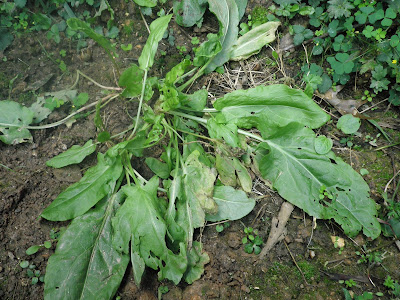 |
| Here I have sorrel growing in a mostly-shade section of the garden |
Asparagus - The name of the game with this edible perennial plant is patience. If you recall from my last post on the garden, I got very impatient and just assumed the asparagus had died, but a few weeks later a bunch of "leaves" popped right out of the ground. Well, since that time, the three crowns that did grow have been slowly (and I mean slooooowly) adding a spear or two every couple of weeks. I now understand why the plant can't be harvested any time in the first few years. There's really not even much to harvest.
Still, I am thankful that the crowns did eventually grow. The plants seem healthy as far as I can tell, although my son managed to mangle the one purple variety pretty badly. I'm planning on buying more crowns next year for sure.
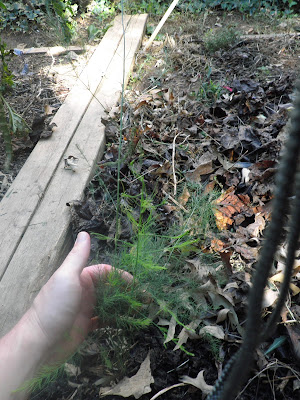 |
| Asparagus only grew a bit over the entire summer |
Other perennials - My wife managed to find some "wild" raspberries in the woods behind our house, so we transplanted one of the canes into our garden. The other two varieties we already had produced lots of delicious berries for us.
 |
| Delicious black raspberries... |
The only other edible perennial plants that I have are four blueberry bushes, and two pear trees. The blueberries did produce a lot more berries than in previous years, but they unfortunately got snacked on by the birds before we could get to it. As for the pears, well, the trees developed fire blight last year and had to be severely pruned, which hurt its spring growth earlier this year. Between both trees there was only one flower blooming when they budded out. And as I've mentioned before, we need another variety of pear tree to provide pollination for the blooms, since apparently same varieties won't pollinate each other. We didn't research this beforehand and bought two "Barlett" pear trees.
The new pear tree will planted later this winter, and we plan to use netting on the blueberries to keep the birds from eating them. Hopefully, that will solve each problem next year.
Final Thoughts
I'm convinced that 2015 was the most productive gardening season for the Dow Dominion yet. We enjoyed a long harvest of spring veggies like lettuce, kale and spinach. Then, right as those tender greens were bolting, we started harvesting lots of delectable tomatoes, several types of beans, berries of all sorts, and various herbs like oregano, basil and thyme. We did have a few failures, but less than any year prior. The Dow household is still far from having a self-sufficient food supply, but this year we made great progress towards that lofty goal... more so than ever before.
I think the most valuable lesson I learned from this season is just to try! In the past, I've been reluctant to test different things that I thought would be a good idea, maybe because it seems like too much work, or that it wouldn't work at all. I let go of some of those fears this year, as I really don't have much to lose from just trying out different plants, different spots to grow, different ways to improve the soil, and different ways to utilize water. Just try it, keep doing the things that work, and drop the things that don't!
Now that fall is here, the production of my garden is pretty much done, so I'm using the time to clean up dead plant material, spread leaf mulch over my garden beds, and plan for an even more productive year in 2016. I hope you enjoyed taking a look at the photos of my garden this year, and perhaps inspired you to try some of the various plant varieties I grew this year.
I have several new articles in the works, some of which deal with the apple tree nursery I'm going to be starting, some covering various topics of backyard permaculture, and others completely unrelated to agriculture. If you enjoyed this post (or any of my articles), please consider subscribing and sharing with your friends! Thanks for reading, and come back soon for more content.
 |
| Stay tuned for more from this guy! |
Comments